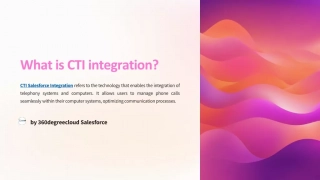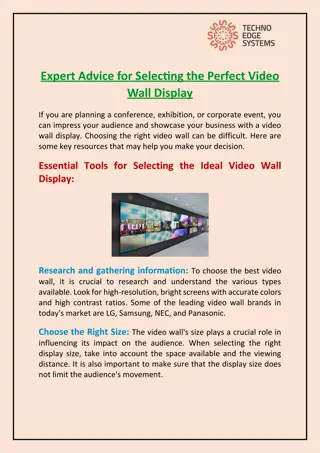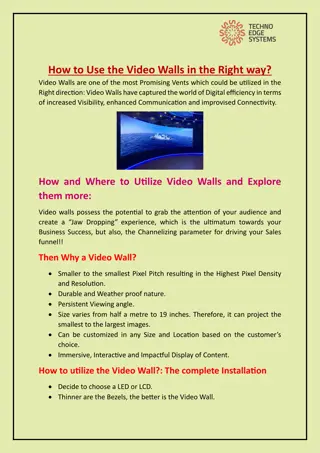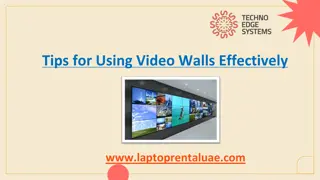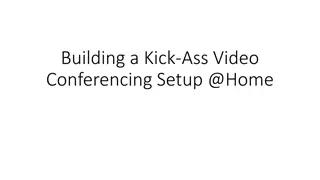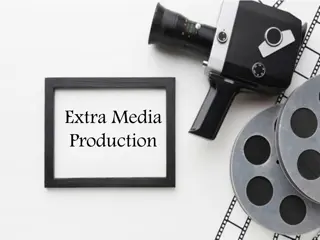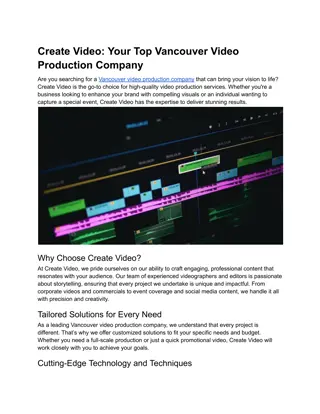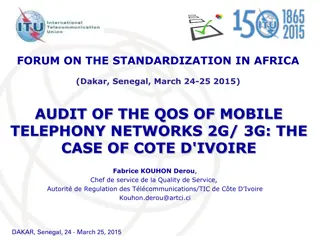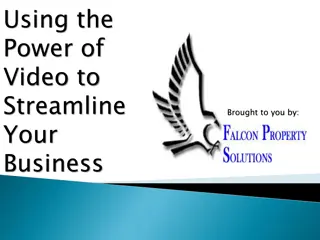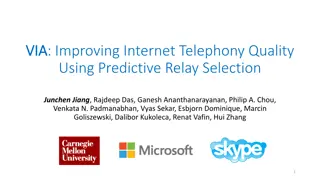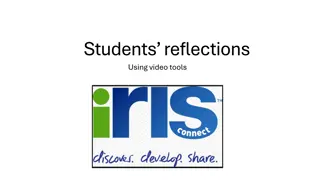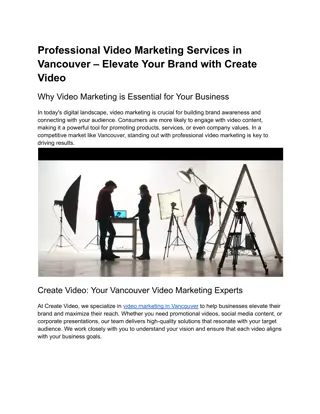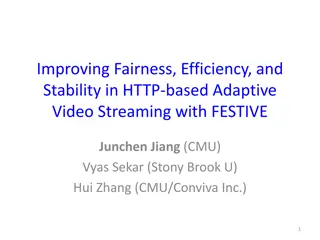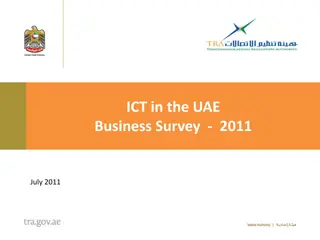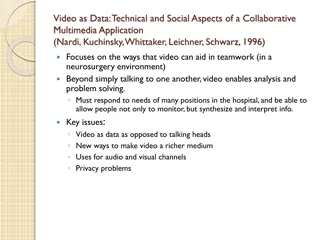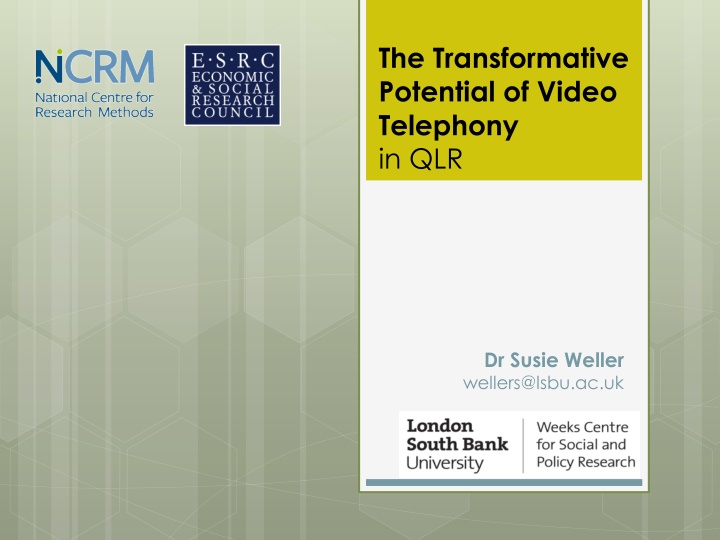
Transformative Potential of Video Telephony in Qualitative Longitudinal Research
Explore the implications of integrating video telephony into qualitative longitudinal research, focusing on data generation and participant engagement over multiple waves. The study tracks young individuals from childhood to adulthood, documenting their evolving relationships, experiences, and self-perceptions. Funding sources and key data collection phases are outlined, showcasing a shift towards remote methods in later waves. Areas of interest include significant life events, familial dynamics, hopes for the future, and everyday routines. The sample is diverse, distributed across rural, suburban, and urban areas in the UK.
Uploaded on | 1 Views
Download Presentation

Please find below an Image/Link to download the presentation.
The content on the website is provided AS IS for your information and personal use only. It may not be sold, licensed, or shared on other websites without obtaining consent from the author. If you encounter any issues during the download, it is possible that the publisher has removed the file from their server.
You are allowed to download the files provided on this website for personal or commercial use, subject to the condition that they are used lawfully. All files are the property of their respective owners.
The content on the website is provided AS IS for your information and personal use only. It may not be sold, licensed, or shared on other websites without obtaining consent from the author.
E N D
Presentation Transcript
The Transformative Potential of Video Telephony in QLR Dr Susie Weller wellers@lsbu.ac.uk
Introduction PROJECT AIM o To investigate the implications of introducing video telephony as a new method of data generation into an established QLR project for two purposes: possible use of such interviews for providing 'catch up' data about participants' lives between researcher visits, thereby helping to ensure their long-term engagement and generating data. implications for using such interviews as a time-efficient and cost-effective alternative to, or augmentation of, face-to-face co-present interviews.
Rationale GAPS IN KNOWLEDGE Possibilities and drawbacks in mediated data collection. Using video telephony in qualitative longitudinal research. o o REMOTE MODES IN LONGITUDINAL RESEARCH Large scale survey field - implications for retaining and working with an established sample. Qualitative field lacking in discussion surrounding data collection by phone/online. o o KEY CONCERNS Data quality, research relationship and rapport between these different interview modes. o
The Study FOCUS o Tracking 50 young people from mid-childhood to adulthood. o Documenting the meanings, experiences and flows of prescribed and chosen relationships, and how these relate to their sense of self as their individual and family biographies unfold. FUNDING o Builds on samples of children from three previous Families & Social Capital ESRC Research Group projects (2003-2007). o Two further phases - ESRC Timescapes Programme (2007-2011). o Current - ESRC National Centre for Research Methods (2013-2015). MAIN WAVES OF DATA COLLECTION o W1, 2002-05, aged 6-13. o W2, 2007, aged 10-17. o W3, 2009, aged 12-19. o W4, 2013, aged 16-23.
Data Generation AREAS OF INTEREST ACROSS THE WAVES Significant life events; change/continuity in familial relationships and friendships; routines and responsibilities; hopes and fears for the future; and everyday life at home, school/college/work etc. o METHODS Waves 1-3: In-depth interviews in participant s home incl. creative methods such as photography, networking mapping, vignettes. Interim activities: Postal and online; public engagement e.g. V&A Museum of Childhood event, BBC Memoryshare, YouTube video. Wave 4: Shift to remote methods. o o o
Sample o The sample is nationally distributed across rural and suburban areas in England, Scotland Wales. urban, and o NB. there is much diversity within the categories listed.
Approach TASK Compare the three waves of data generated over the past decade using physically co-present interviews with a new wave of data generated using video telephony (and telephony). o PARTICIPATORY APPROACH All participants. Feedback at the end of the interview and via online survey exploring: (i) interview experience; (ii) disclosure; (iii) imagined future engagement; and (iv) relationship with the researcher? o o AN INTERACTIONIST FRAMEWORK 10 extended interviews. To assess the implications of remote technology as against physical co-present communication for the research relationship and rapport. o o
Video Telephony o Digital technologies = part of a socialscientist s toolkit - aided by vast in internet usage, reliability of broadband connections/bandwidth. o Range audio/video communication. Examples include: o Skype: audio, conferencing/ group discussions, file transfer. o FaceTime:video chat, group FaceTime/conference calls. o Google Hangouts: instant discussions (up to 10 people), photo and emoji sharing. o Video chat apps: e.g. Fring (audio/video calls, group video calls). of technologies enabling two-way real-time video, instant messaging, video messaging, voice/video o Focus on accessible free applications using Video Over Internet Protocol as opposed to specific video phones or teleconferencing.
Video Telephony and QLR IN QUALITATIVE RESEARCH o Potential use relatively under-explored in qualitative interviewing, particularly with respect to being a substitute for face-to-face interaction. o Majority of recent papers call for more research into especially differences between modes (e.g. Sullivan 2012). IN QLR o Not capitalised upon beyond maintaining contact due to concerns about: accessibility, confidentiality, rapport. POSSIBILITIES Data generation with individuals or groups (incl. geographically distributed) via mobile phone, tablet, laptop, TV, games consoles connected to other social media (e.g. Skype linked to Facebook). o
How To COMMUNICATION EQUIPMENT (researcher & participant) Good broadband internet connection/wifi/mobile data package, webcam and microphone (earphones optional). Importance of checking positioning of equipment e.g. webcam, microphone. o o RECORDING EQUIPMENT Pamela for Skype (www.pamela.biz/en/) approx. 25 IM Capture (http://imcapture.com/) packages for Skype, FaceTime and Yahoo Messenger approx. 30 each. Effective but need to have good back-up - Marantz recorder (.WAV ). o o o
Preliminary Findings OVERVIEW Unforeseen uptake of mobile interviews - greater flexibility for transient lives. o Extended interviews - more likely to opt for Skype. o Catch-up interview - preference for phone, often mobile. o Three chose FaceTime but curtailed by technical challenges. o For a further 3 I had to rely on short updates from their mothers. o Mode Skype FaceTime Phone - landline Phone - mobile Correspondence with parent Catch-up 6 0 4 13 3 Extended 6 0 2 2 0 TOTAL 12 0 6 15 3 % 33 0 17 42 8
Participants Perspectives 92% of respondents (n=12) were positive about being interviewed online/by phone. FLEXIBILITY AND CONVENIENCE o Hanna (2012) - flexibility and versatility as advantages - busy lives may not have been able to accommodate a face-to- face co-present interview. o Some carried on with day-to-day activities during interview e.g. having lunch, making coffee, organising papers on desk. o May need to be more flexible with remote methods than with co-present interviews especially given technical challenges and where participants seem to feel more able to alter time/date, sometimes with little notice. o Deakin & Wakefield (2013) found a great incidence of absentees but less likely where established relationship.
Rapport Generally good (100% survey respondents comfortable with remote mode) - more favourable/easier to gauge with video. Good quality, sustained audio and/or video essential . Some able to draw on range of technologies if necessary. Participants confidence with mode /shift in mode significant Chosen mode does not necessarily equate to confidence. Pressure of presence - remote modes as less formal/daunting. Detached but less intrusive. Observation of/responses to non-verbal gestures, body language, etc. important Some felt phone useful for catchup interviews but video telephony or co-present interviews necessary for more in-depth discussions. o o o o o o
Willingness to Divulge On the whole and as long as comfortable with mode just as willing to divulge detail of their lives Mode and duration of interviews May be different for one off interviews?? Many participants had concerns about what might be lacking. E.g. facial expressions, meanings underlying statements etc. A number also felt that they were less focused/clear and thorough. Less aware of recording (Deakin & Wakefield 2013). o o o o SENSITIVE AND EMOTIVE ISSUES o Sometimes unforeseen - even in the context of QLR. o Feelings of inadequacy - concerns about the lack of ability to demonstrate care (empathy, sympathy etc.) in an effective and meaningful manner.
Conversation Flow Poor audio/video - much energy is consumed (re)listening to responses . A strong and sustained connection is essential for mitigating against disruptions and interruptions in the flow of conversation. Just because audio/video clear for researcher not necessarily the case for participant. Skype to mobile not always clear sometimes echo on line - propensity to interrupt one another. False starts - re-connecting Skype or shifting mode In these instances much time spent discussing ways of re- connecting/improving connection. Odd instance where had to terminate and re-call. Audio only - difficult to judge when a participant has finished responding to a particular question. o o o
Research Relationships Strengthened with some; more distant/remote with others. Shift in mode appears to have deterred some (e.g. shy/self conscious, previously undisclosed participating but enabled others to take part (e.g. busy and/or transient lives, precarious existences). Possibility of enhancing access/availability especially as now widely available on a multitude of devices but may be useful with some but not others. Long-term relationship with/commitment to project. Common for participants to express concern for my well-being. Changes with significant others. Other forms of research relationships with family and friends. o disabilities) from o o o o CONTEXT o Missing context of participant s lives by not visiting their homes. o Less aware of spatial circumstances. o Video connection can offer insights into new/re-shaped spaces.
Ethical Issues INFORMED CONSENT o Importance of clarity over potential implications for anonymity. o Challenges of gaining written consent online. ANONYMITY AND CONFIDENTIALITY o Confidentiality (e.g. Skype recording interviews) (Sullivan 2012). o Anonymity and concernsabout being filmed (Deakin & Wakefield 2013). o Failure of one technology/need to shift to an alternative meant some interviews were conducted in more public spaces. o For some, offered a more private space with less disruption researcher not always aware of spatial context and levels of privacy.
Conclusions o Value of remote methods in QLR: o Geographical distribution of sample. o Through times of significant transition. o Sample maintenance. o Quality of existing relationship. o Confidence in mode. o Potential for interim data and as a means of sustaining contact. o Caution sensitive or emotive issues
Selected References o Bertrand, C. & Bourdeau, L. (2010) Research interviews by Skype: A new data collection method , in J. Esteves (Ed.), Proceedings from the 9th European Conference on Research Methods, Spain: IE Business School: 70-79. o Briggs H (2013) Skype interviews: is it more tricky to be grilled by video? Available at: http://www.bbc.co.uk/news/magazine- 21334710 (accessed 11 March 2013). o Deakin, H. and Wakefield, K. (2013) SKYPE interviewing: reflections of two PhD researchers ,Qualitative Research, published online May 2013. o Hanna, P. (2012) Using internet technologies (such as Skype) as a research medium: a research note ,Qualitative Research, Vol. 12(2): 239-242. o Sullivan, J. R. (2012) Skype: An Appropriate Method of Data Collection for Qualitative Interviews? ,The Hilltop Review: Vol. 6(1), Article 10.
Further Project Information Your Space! project : www.lsbu.ac.uk/ahs/research/yourspace/ o National Centre for Research methods Methodological Innovation Projects : www.ncrm.ac.uk/research/MIP/ o Contact: Susie Weller wellers@lsbu.ac.uk (maternity leave until 1st October 2014). o

